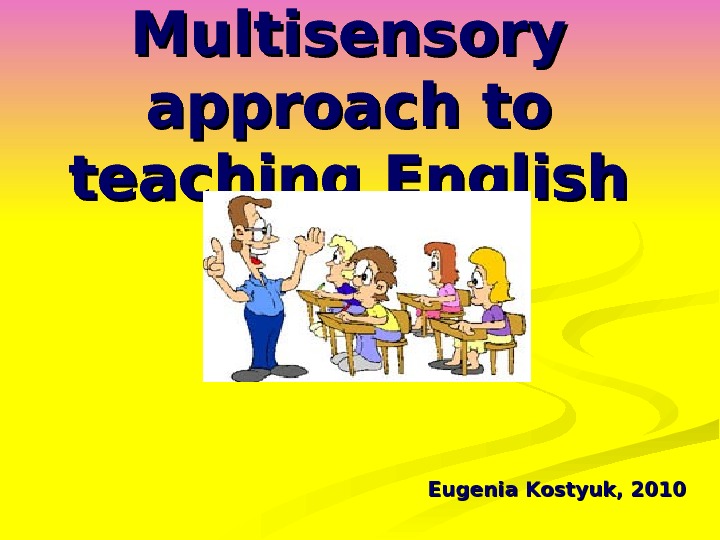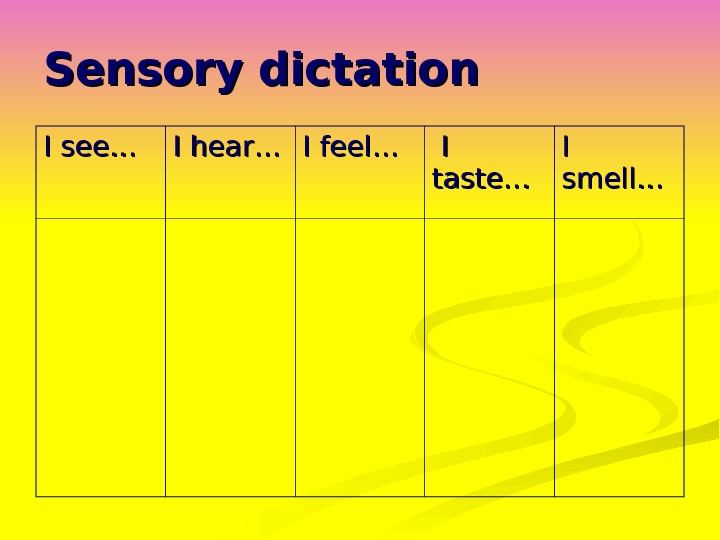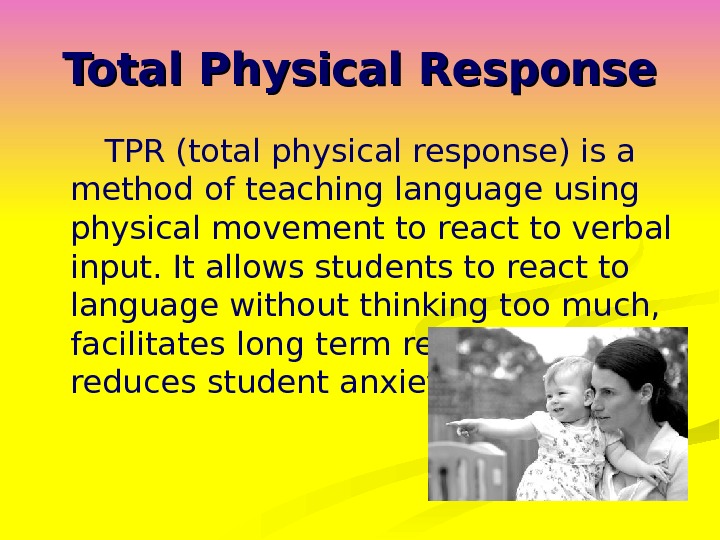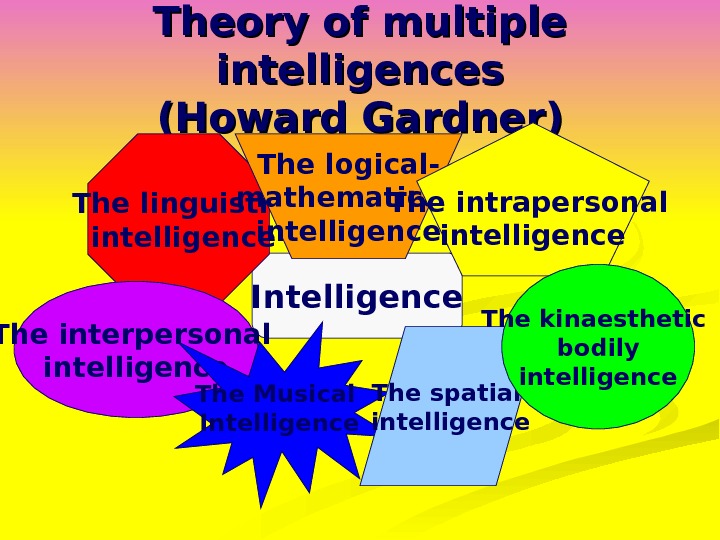Multisensory approach to teaching English Eugenia Kostyuk, 2010






















multisensory_approach_to_teaching_english_1.ppt
- Размер: 664.5 Кб
- Количество слайдов: 21
Описание презентации Multisensory approach to teaching English Eugenia Kostyuk, 2010 по слайдам
 Multisensory approach to teaching English Eugenia Kostyuk,
Multisensory approach to teaching English Eugenia Kostyuk,
 Sensory dictation I see… I hear… I feel… I I taste… I I smell…
Sensory dictation I see… I hear… I feel… I I taste… I I smell…
 Multisensory approach. Total Physical Response (TPR) Theory of Multiple Intelligences. Neuro-Linguistic Programming (NLP)
Multisensory approach. Total Physical Response (TPR) Theory of Multiple Intelligences. Neuro-Linguistic Programming (NLP)
 Total Physical Response TPR (total physical response) is a method of teaching language using physical movement to react to verbal input. It allows students to react to language without thinking too much, facilitates long term retention, and reduces student anxiety and stress.
Total Physical Response TPR (total physical response) is a method of teaching language using physical movement to react to verbal input. It allows students to react to language without thinking too much, facilitates long term retention, and reduces student anxiety and stress.
 NLPNLP Body-mind connection
NLPNLP Body-mind connection
 NLPNLP “ Each of us has within us whatever we need in order to achieve what we want to”
NLPNLP “ Each of us has within us whatever we need in order to achieve what we want to”
 Theory of multiple intelligences (Howard Gardner) Intelligence. The linguistic intelligence The logical- mathematical intelligence The intrapersonal intelligence The interpersonal intelligence The Musical Intelligence The spatial intelligence The kinaesthetic bodily intelligence
Theory of multiple intelligences (Howard Gardner) Intelligence. The linguistic intelligence The logical- mathematical intelligence The intrapersonal intelligence The interpersonal intelligence The Musical Intelligence The spatial intelligence The kinaesthetic bodily intelligence
 Multisensory approach Whole-brain approach
Multisensory approach Whole-brain approach
 Language work Lexis + grammar + pronunciation
Language work Lexis + grammar + pronunciation
 Grammar ““ Moving in time” Irregular verbs
Grammar ““ Moving in time” Irregular verbs
 Grammar Mime the grammar While I was watching a comedy the cake got burnt. I’m going to ski down the hill. I’ve won in a lottery and now I can buy a car. I’ve been painting the wall for three hours and now I’m tired.
Grammar Mime the grammar While I was watching a comedy the cake got burnt. I’m going to ski down the hill. I’ve won in a lottery and now I can buy a car. I’ve been painting the wall for three hours and now I’m tired.
 Pronunciation ““ Sound Machine” Storytelling
Pronunciation ““ Sound Machine” Storytelling
 Punctuation ““ Percussion punctuation”
Punctuation ““ Percussion punctuation”
 john was out in the garden looking for something he was on hands and knees in flower border his wife saw him from an upstairs window opened the window and called down to him what are you doing im looking for my keys your keys lost them in the garden did you no in the house then why are you looking for them in the garden he straightened his back and looked up to her the light is better in the garden
john was out in the garden looking for something he was on hands and knees in flower border his wife saw him from an upstairs window opened the window and called down to him what are you doing im looking for my keys your keys lost them in the garden did you no in the house then why are you looking for them in the garden he straightened his back and looked up to her the light is better in the garden
 john was out in the garden // // looking for something // // he was on hands and knees in flower border //// his wife saw him from an upstairs window //// opened the window and called down to him //// what are you doing //// im im looking for my keys //// your keys //// lost them in the garden //// did you //// no no //// in in the house //// then why are you looking for them in the garden // // he he straightened his back and looked up to her //// the light is better in the garden
john was out in the garden // // looking for something // // he was on hands and knees in flower border //// his wife saw him from an upstairs window //// opened the window and called down to him //// what are you doing //// im im looking for my keys //// your keys //// lost them in the garden //// did you //// no no //// in in the house //// then why are you looking for them in the garden // // he he straightened his back and looked up to her //// the light is better in the garden
 John was out in the garden, looking for something. He was on hands and knees in flower border. His wife saw him from an upstairs window, opened the window and called down to him: ““ What are you doing? ” ““ I’m looking for my keys. ” “Your keys? Lost them in the garden, did you? ” ““ No, in the house. ” ““ Then why are you looking for them in the garden? ” He straightened his back and looked up to her: “The light is better in the garden!”
John was out in the garden, looking for something. He was on hands and knees in flower border. His wife saw him from an upstairs window, opened the window and called down to him: ““ What are you doing? ” ““ I’m looking for my keys. ” “Your keys? Lost them in the garden, did you? ” ““ No, in the house. ” ““ Then why are you looking for them in the garden? ” He straightened his back and looked up to her: “The light is better in the garden!”
 Punctuation Peter where Mary had had had had had the teacher’s approval. Peter, where Mary had had “had had” had had “had”. “Had had” had the teacher’s approval.
Punctuation Peter where Mary had had had had had the teacher’s approval. Peter, where Mary had had “had had” had had “had”. “Had had” had the teacher’s approval.
 Speaking “ Human camera”
Speaking “ Human camera”
 Internalizing the language Internalising a poem a…. L…. c…. c…t…t…t…o…t…. t…. I…. t…. a…. n…. s…h…I…. t…. a…. n…. s…h… s…. u…. a…l…h…b…t…. g…. t…. s…. a…. c…. . t…. h…. f…a…. .
Internalizing the language Internalising a poem a…. L…. c…. c…t…t…t…o…t…. t…. I…. t…. a…. n…. s…h…I…. t…. a…. n…. s…h… s…. u…. a…l…h…b…t…. g…. t…. s…. a…. c…. . t…. h…. f…a…. .
 NB! Studens’ motivation depends partly on how “addressed” they feel in the class. Students realise that they can approach the language from their strength areas. Students not only have the opportunity to use their strongest intelligences but also develop their weaker ones.
NB! Studens’ motivation depends partly on how “addressed” they feel in the class. Students realise that they can approach the language from their strength areas. Students not only have the opportunity to use their strongest intelligences but also develop their weaker ones.
 “…“… you are only human insofar as you can play, and you can play insofar as you are human…” Schiller
“…“… you are only human insofar as you can play, and you can play insofar as you are human…” Schiller

